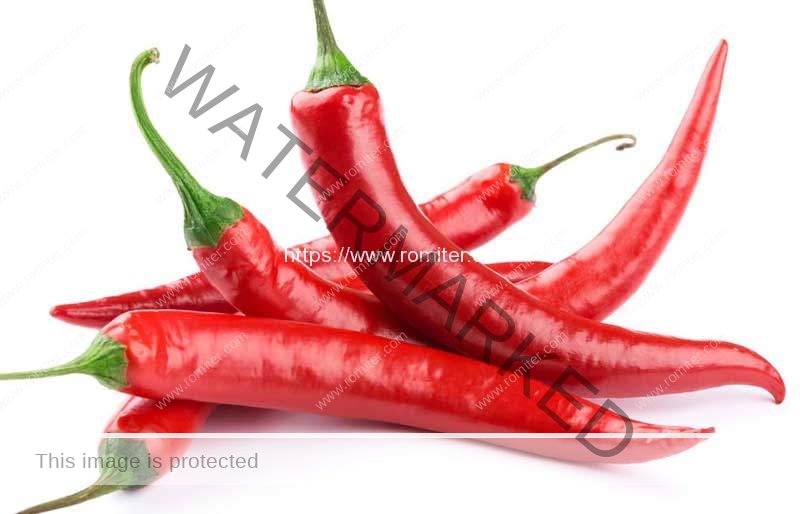The chili pepper (also chile, chile pepper, chilli pepper, or chilli from Nahuatl chīlli Nahuatl pronunciation: [ˈt͡ʃiːli] (About this sound listen)) is the fruit of plants from the genus Capsicum, members of the nightshade family, Solanaceae. Chili peppers are widely used in many cuisines to add spiciness to dishes. The substances that give chili peppers their intensity when ingested or applied topically are capsaicin and related compounds known as capsaicinoids.
Chili peppers originated in Mexico. After the Columbian Exchange, many cultivars of chili pepper spread across the world, used for both food and traditional medicine.
Worldwide in 2014, 32.3 million tonnes of green chili peppers and 3.8 million tonnes of dried chili peppers were produced. China is the world’s largest producer of green chillies, providing half of the global total.
Chili pepper pods, which are berries, are used fresh or dried. Chilies are dried to preserve them for long periods of time, which may also be done by pickling.
Dried chilies are often ground into powders, although many Mexican dishes including variations on chiles rellenos use the entire chili. Dried whole chilies may be reconstituted before grinding to a paste. The chipotle is the smoked, dried, ripe jalapeño.
Many fresh chilies such as poblano have a tough outer skin that does not break down on cooking. Chilies are sometimes used whole or in large slices, by roasting, or other means of blistering or charring the skin, so as not to entirely cook the flesh beneath. When cooled, the skins will usually slip off easily.
The leaves of every species of Capsicum are edible. Though almost all other Solanaceous crops have toxins in their leaves, chili peppers do not.[citation needed] The leaves, which are mildly bitter and nowhere near as hot as the fruit, are cooked as greens in Filipino cuisine, where they are called dahon ng sili (literally “chili leaves”). They are used in the chicken soup tinola.[32] In Korean cuisine, the leaves may be used in kimchi.[33] In Japanese cuisine, the leaves are cooked as greens, and also cooked in tsukudani style for preservation.
Chili is a staple fruit in Bhutan. Bhutanese call this crop ema (in Dzongkha) or solo (in Sharchop). The ema datsi recipe is entirely made of chili mixed with local cheese.
In India, most households always keep a stock of fresh hot green chilies at hand, and use them to flavor most curries and dry dishes. It is typically lightly fried with oil in the initial stages of preparation of the dish. Some states in India, such as Rajasthan, make entire dishes only by using spices and chilies.[citation needed]
Chilies are present in many cuisines. Some notable dishes other than the ones mentioned elsewhere in this article include:
Arrabbiata sauce from Italy is a tomato-based sauce for pasta always including dried hot chilies.
Puttanesca sauce is tomato-based with olives, capers, anchovy and, sometimes, chilies.
Paprikash from Hungary uses significant amounts of mild, ground, dried chilies, known as paprika, in a braised chicken dish.
Chiles en nogada from the Puebla region of Mexico uses fresh mild chilies stuffed with meat and covered with a creamy nut-thickened sauce.
Curry dishes usually contain fresh or dried chiles.
Kung pao chicken (Mandarin Chinese: 宫保鸡丁 gōng bǎo jī dīng) from the Sichuan region of China uses small hot dried chilies briefly fried in oil to add spice to the oil then used for frying.
Mole poblano from the city of Puebla in Mexico uses several varieties of dried chilies, nuts, spices, and fruits to produce a thick, dark sauce for poultry or other meats.
Nam phrik are traditional Thai chili pastes and sauces, prepared with chopped fresh or dry chilies, and additional ingredients such as fish sauce, lime juice, and herbs, but also fruit, meat or seafood.
‘Nduja, a more typical example of Italian spicy specialty, from the region of Calabria, is a soft pork sausage made “hot” by the addition of the locally grown variety of jalapeño chili.
Paprykarz szczeciński is a Polish fish paste with rice, onion, tomato concentrate, vegetable oil, chili pepper powder and other spices.
Sambal terasi or sambal belacan is a traditional Indonesian and Malay hot condiment made by frying a mixture of mainly pounded dried chili s, with garlic, shallots, and fermented shrimp paste. It is customarily served with rice dishes and is especially popular when mixed with crunchy pan-roasted ikan teri or ikan bilis (sun-dried anchovies), when it is known as sambal teri or sambal ikan bilis. Various sambal variants existed in Indonesian archipelago, among others are sambal badjak, sambal oelek, sambal pete (prepared with green stinky beans) and sambal pencit (prepared with unripe green mango).
Som tam, a green papaya salad from Thai and Lao cuisine, traditionally has, as a key ingredient, a fistful of chopped fresh hot Thai chili, pounded in a mortar.
Fresh or dried chilies are often used to make hot sauce, a liquid condiment—usually bottled when commercially available—that adds spice to other dishes. Hot sauces are found in many cuisines including harissa from North Africa, chili oil from China (known as rāyu in Japan), and sriracha from Thailand. Dried chilies are also used to infuse cooking oil.















